You’ve probably never considered what makes your favorite jewelry non-vegan, but the truth might surprise you. Many traditional pieces contain animal-derived materials you wouldn’t expect, while their production methods often harm both wildlife and ecosystems. As conscious consumers increasingly demand transparency, understanding these hidden ingredients becomes essential for making informed choices. The jewelry industry’s impact extends far beyond what meets the eye, affecting everything from coral reefs to…
Understanding What Makes Jewelry Non-Vegan
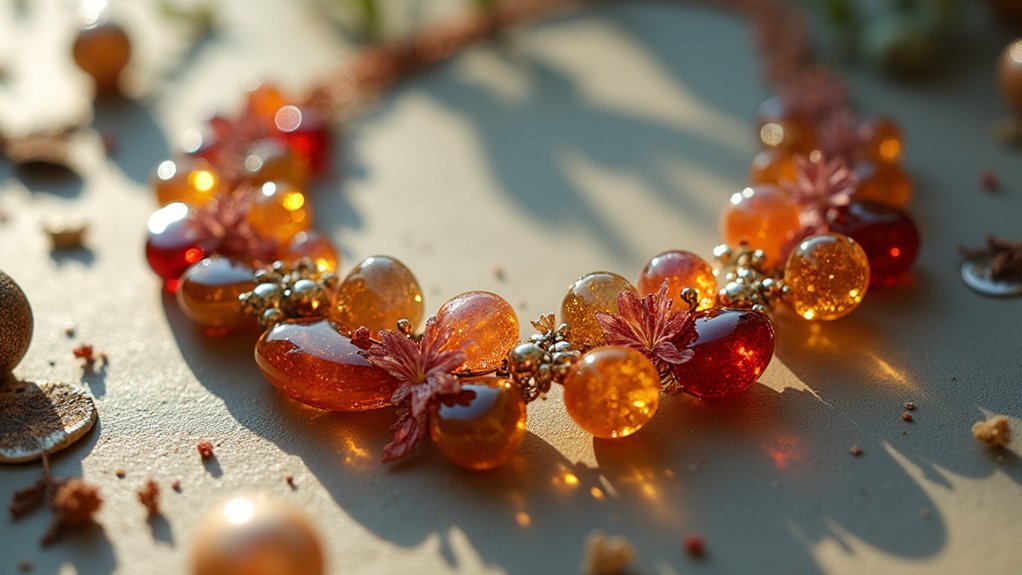
When you’re shopping for jewelry, you mightn’t realize how many pieces contain animal-derived materials that contradict vegan principles.
Pearls represent one of the most common non-vegan components, created through processes that stress and often kill molluscs.
Pearl production involves subjecting molluscs to stressful conditions that frequently result in their death, making them unsuitable for vegan jewelry choices.
Leather straps and cords frequently use materials from cows, pigs, and sometimes endangered species, directly contributing to animal exploitation.
You’ll also encounter jewelry featuring bones, feathers, and shells – all sourced from animals.
Silk threads used in jewelry production come from silkworms, making these pieces unsuitable for vegans.
Even traditional mining practices for diamonds and gold destroy wildlife habitats, affecting countless animals.
Making ethical choices means recognizing these animal-derived materials and understanding their impact on animal welfare before making purchasing decisions.
Animal-Derived Materials Commonly Found in Traditional Jewelry
Although you might expect jewelry to contain only metals and stones, countless traditional pieces incorporate animal-derived materials that make them unsuitable for ethical consumers. You’ll find these animal products hidden throughout conventional jewelry collections, often without clear labeling.
| Material Category | Common Sources | Ethical Concerns |
|---|---|---|
| Organic Components | Pearls, shells, coral | Mollusc stress, marine ecosystem damage |
| Structural Elements | Leather straps, bone inlays | Animal slaughter, endangered species exploitation |
| Decorative Features | Feathers, teeth, horns | Wildlife cruelty, habitat destruction |
| Production Materials | Collagen-based adhesives | Hidden animal derivatives |
These non-vegan materials compromise your values while contributing to environmental degradation. Traditional harvesting methods cause unnecessary animal suffering, making it essential to identify and avoid such components when selecting ethical jewelry pieces.
Environmental Impact of Conventional Jewelry Production

Beyond the ethical concerns surrounding animal-derived materials, conventional jewelry production devastates our planet through environmentally destructive practices.
You’re contributing to massive ecosystem disruption when you purchase traditionally-made jewelry, as mining affects 70% of the world’s ecosystems through habitat destruction and biodiversity loss.
Every traditionally-made jewelry purchase directly fuels the destruction of ecosystems worldwide through harmful mining practices and habitat loss.
The environmental impact extends to severe water pollution, where toxic materials contaminate local sources affecting wildlife and communities alike.
Gold mining alone generates 20% of global carbon emissions, accelerating climate change.
When you buy one gold ring, you’re responsible for releasing up to 20 tons of waste through energy-intensive mining and refining processes.
Choosing ethical production methods through vegan materials dramatically reduces these devastating environmental consequences while supporting sustainable practices.
Essential Vegan Materials for Ethical Jewelry Making
When you’re creating ethical jewelry, you’ll find that lab-created gemstones offer brilliant alternatives to mined stones without the environmental destruction or ethical concerns.
These synthetic gems possess identical chemical properties to their natural counterparts while eliminating mining’s ecological footprint.
You can also choose sustainable metal alternatives like recycled gold and silver, which reduce the demand for new mining operations and their associated environmental damage.
Lab-Created Gemstone Options
The jewelry industry’s shift toward lab-created gemstones represents a revolutionary approach to ethical manufacturing that doesn’t compromise on beauty or quality.
When you choose lab-created gemstones, you’re selecting options that meet the highest ethical standards while delivering identical chemical properties to their mined counterparts.
These synthetic alternatives use 90% less water and produce fewer carbon emissions than traditional diamond mining.
You’ll discover incredible design flexibility with lab-created stones available in various colors and styles. Options like Moissanite and Cubic Zirconia make ethical jewelry affordable and accessible.
Most importantly, lab-created gemstones guarantee complete supply chain transparency.
You can trust that no unethical labor practices or environmentally harmful mining operations contributed to your jewelry’s creation.
Sustainable Metal Alternatives
As sustainable jewelry making evolves, you’ll find that metal alternatives offer compelling solutions that greatly reduce environmental impact while maintaining the durability and beauty you expect.
Recycled metals like reclaimed gold and silver repurpose existing materials, eliminating the need for destructive mining practices. Lab-grown metals provide controlled production with remarkably lower carbon footprints than traditional extraction methods.
You can explore bio-based alternatives such as plant-derived resins that create lightweight, durable pieces without animal by-products. Surgical steel offers hypoallergenic properties perfect for sensitive skin while remaining corrosion-resistant.
When you choose fair-mined metals, you’re supporting responsible labor practices and social equity. These sustainable materials demonstrate that ethical and sustainable jewelry doesn’t require compromising on quality or aesthetics.
Lab-Grown Gemstones as Sustainable Alternatives
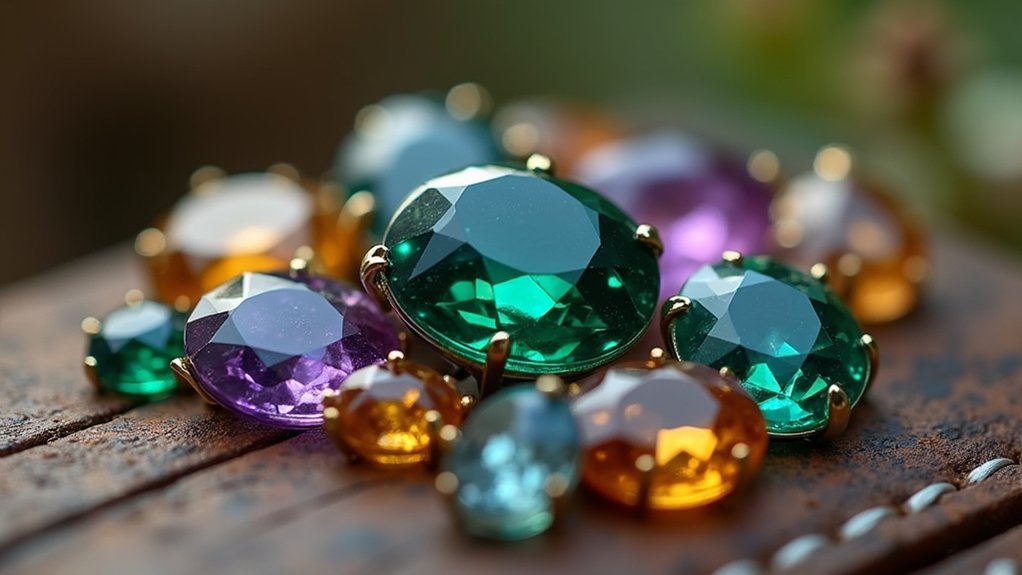
While traditional gemstone mining devastates landscapes and exploits workers, lab-grown gemstones offer you a revolutionary alternative that doesn’t compromise on beauty or quality.
These scientifically created gems are chemically identical to mined stones but generate 90% fewer carbon emissions through controlled production processes.
You’ll find lab-grown gemstones can be produced in weeks rather than years, making them more accessible while maintaining exceptional standards.
Their ethical origins come with extensive certification and traceability, so you can verify your jewelry’s sustainable background.
The market’s explosive 22% annual growth reflects consumers like you demanding environmentally responsible options.
When you choose lab-grown gemstones, you’re supporting innovative technology that eliminates environmental destruction while delivering stunning, ethically sourced jewelry that aligns with your values.
Recycled Metals and Their Environmental Benefits
Choosing recycled metals for your jewelry transforms waste into treasure while slashing environmental impact by up to 95%. You’re supporting sustainability by dramatically reducing energy consumption and carbon emissions compared to newly mined materials. This ethical approach diverts waste from landfills while maintaining the same quality and durability you expect.
| Environmental Impact | New Metals | Recycled Metals |
|---|---|---|
| Energy Consumption | 100% | 5% |
| Habitat Destruction | Extensive mining damage | Zero additional impact |
| Pollution Generation | Water/air contamination | Minimal processing impact |
When you select recycled metals, you’re protecting ecosystems from mining destruction and reducing pollution that threatens local communities. Your choice promotes a circular economy that preserves natural resources while creating beautiful, ethical jewelry pieces.
Plant-Based Alternatives to Leather and Natural Fibers
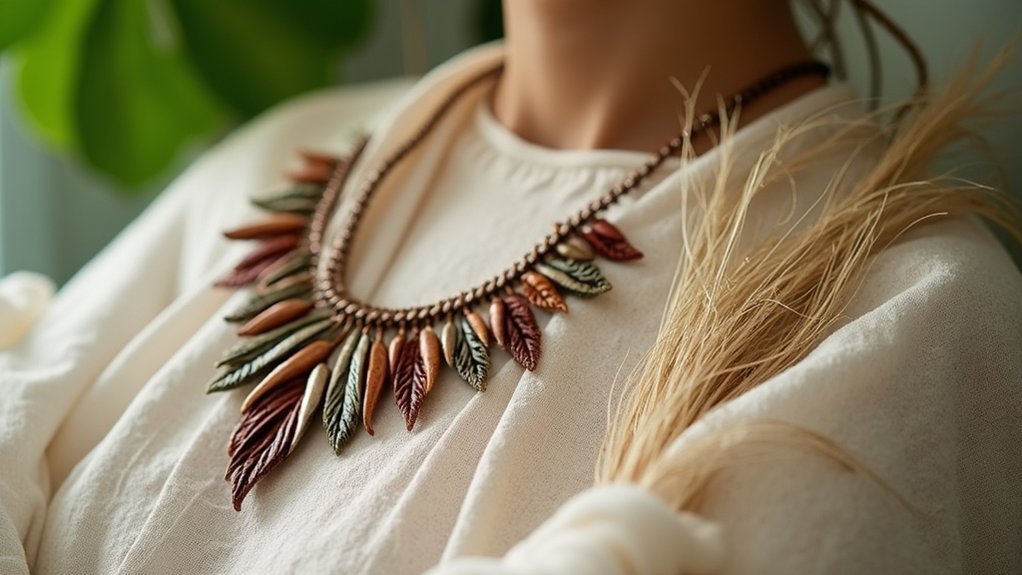
You’ll discover cork-based jewelry components offer incredible versatility while maintaining your commitment to cruelty-free accessories.
These renewable materials don’t just match traditional leather’s appeal—they often surpass it in durability and unique texture.
Bio-resin fiber applications open up endless design possibilities, letting you create stunning pieces that align with your ethical values without compromising on style.
Cork-Based Jewelry Components
Innovation drives the jewelry industry toward sustainable alternatives, and cork has emerged as a remarkable plant-based substitute for traditional leather components.
You’ll discover that cork offers exceptional benefits without contributing to animal cruelty. Harvested from cork oak bark without harming trees, this renewable resource provides lightweight, durable, and water-resistant properties that surpass traditional leather’s performance.
You can choose from various colors and finishes while enjoying cork’s superior insulation and breathability for enhanced comfort.
Bio-Resin Fiber Applications
While traditional jewelry manufacturing relies heavily on petroleum-based plastics and animal-derived materials, bio-resin fibers revolutionize ethical accessory design by combining plant-sourced resins with natural fibers like jute and hemp.
You’ll discover that bio-resin offers exceptional versatility, crafted from renewable sources like corn and sugarcane to create stunning jewelry pieces.
These vegan alternatives perfectly emulate leather’s texture and aesthetic without compromising your ethical values. You’re choosing a cruelty-free material that maintains style and functionality while supporting environmental sustainability.
Bio-resin’s lightweight, flexible qualities make it ideal for comfortable everyday wear. When you select bio-resin jewelry, you’re actively reducing carbon emissions and supporting biodegradable materials that won’t harm our planet’s future.
Synthetic Pearls and Bio-Resin Options
As consumer demand for ethical alternatives grows, synthetic pearls and bio-resins have emerged as compelling solutions that don’t compromise on beauty or quality.
You’ll find that synthetic pearls, crafted from glass or plastic materials, deliver the lustrous elegance of traditional pearls without exploiting marine life or supporting harmful farming practices.
Bio-resins offer you another sustainable choice, derived from renewable plant sources instead of petroleum-based plastics.
You’re getting biodegradable materials that won’t contribute to landfill pollution while maintaining durability for jewelry wear.
Both options give you incredible customization possibilities.
You can choose from diverse colors, finishes, and styles that adapt to current fashion trends.
Identifying Authentic Vegan Jewelry Through Certifications
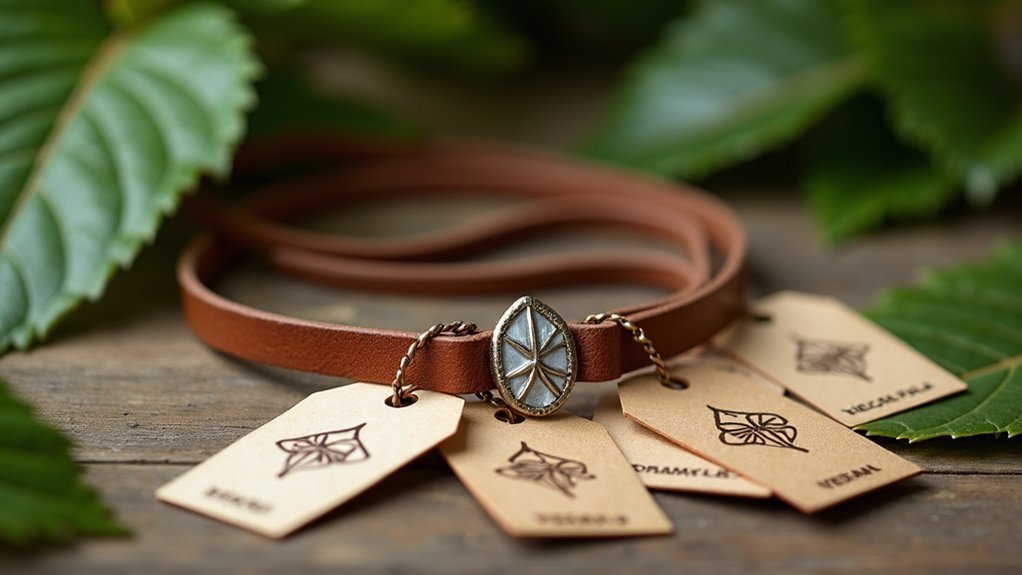
How can you be certain that the jewelry you’re purchasing truly aligns with your vegan values? Look for third-party certifications that guarantee ethical sourcing and authentic vegan materials. These credentials provide transparency in an often complex global supply chain.
| Certification | Purpose |
|---|---|
| Fair Trade Certified | Guarantees equitable pay and safe working conditions for artisans |
| Kimberly Process | Helps avoid conflict diamonds through verified sourcing |
| Fairmined | Ensures sustainably mined metals supporting small-scale communities |
| Clear Material Documentation | Confirms products are free from animal by-products |
You’ll want to examine clear labeling and documentation regarding material sourcing. Third-party certifications eliminate guesswork, helping you navigate the jewelry industry’s complexities. These standards create trust between you and manufacturers while supporting environmental protection and fair labor practices throughout the production process.
Quality Assessment for Vegan Jewelry Materials
Beyond verifying certifications, you’ll need to evaluate the actual quality of vegan jewelry materials to confirm your purchase delivers both ethical integrity and lasting value.
Your quality assessment should begin with examining metal purity—confirm recycled metals are contaminant-free and meet industry safety standards.
Inspect synthetic gemstones for clarity, color consistency, and precise cuts that rival natural stones’ brilliance.
Look for hypoallergenic materials like surgical steel or titanium that prevent skin irritation.
Evaluate craftsmanship by checking construction quality and attention to detail.
Lab-grown diamonds and plant-based resins in ethically sourced pieces should demonstrate durability and professional finishing.
This thorough assessment confirms your vegan jewelry maintains its beauty and value over time.
Cost Considerations When Choosing Vegan Options
When you’re shopping for vegan jewelry, you’ll find that pricing factors vary considerably based on materials and manufacturing processes.
Lab-grown gemstones can save you 20-40% compared to mined stones, while recycled metals often cost less than newly extracted materials.
However, you should evaluate the long-term value since higher upfront costs for certified ethical pieces typically translate to better durability and fewer replacements over time.
Pricing Factors Analysis
Understanding the financial landscape of vegan jewelry requires examining several key cost drivers that influence your purchasing decisions. When you’re shopping for vegan jewellery, the materials used directly impact pricing through multiple factors.
| Cost Factor | Traditional Impact | Vegan Alternative Impact |
|---|---|---|
| Raw Materials | Mined diamonds/metals | Lab-grown gems 20-40% cheaper |
| Production Setup | Standard processes | Higher initial sustainable investment |
| Certification | Basic standards | Premium ethical certifications |
Lab-grown diamonds and synthetic gemstones offer immediate savings, while recycled metals reduce long-term production costs. However, you’ll notice certification processes for ethical standards can increase upfront prices. Despite higher initial investments in sustainable sourcing, vegan materials often become more cost-effective over time due to reduced energy requirements and resource efficiency, making your ethical choice financially smart.
Long-Term Value Assessment
Your investment in vegan jewelry extends far beyond the initial purchase price, creating a value proposition that strengthens over time. While you might pay comparable or slightly higher upfront costs, the durability of high-quality vegan materials means you’ll replace pieces less frequently.
This sustainable approach delivers superior long-term value through reduced replacement expenses.
You’re also investing in ethical production practices that eliminate costs associated with labor exploitation and environmental damage. These eco-friendly methods support fair wages while promoting recycling and upcycling practices that enhance overall piece value.
As consumer demand grows, you’ll benefit from increased innovation and competition, driving down future prices while improving quality in this expanding market.
Proper Care and Maintenance of Vegan Jewelry
Although vegan jewelry offers an ethical alternative to traditional pieces, it requires specific care techniques to preserve its beauty and extend its lifespan.
Vegan jewelry provides a compassionate choice for conscious consumers, though it demands specialized maintenance to ensure lasting elegance and durability.
You’ll need to clean your pieces with gentle, non-toxic solutions that won’t damage synthetic pearls or plant-based resins. Store them in cool, dry places away from humidity and temperature extremes.
Regular inspection becomes essential for proper care of materials like bio-plastics, helping you spot wear early.
Skip ultrasonic cleaners, as they can harm protective coatings on delicate components. Always remove your jewelry before swimming or using household chemicals – these can cause adverse reactions with synthetic gems and plant-based materials.
Following these maintenance guidelines guarantees your ethical pieces remain beautiful for years.
Fair Trade Practices in Vegan Jewelry Production
When you choose Fair Trade vegan jewelry, you’re supporting a movement that prioritizes both animal welfare and human rights throughout the production process.
Fair Trade certification guarantees that artisans receive equitable wages and work in safe conditions, promoting social justice within the industry. You’ll know your purchase contributes to the economic empowerment of marginalized communities, helping uplift their living and working standards.
Fair Trade practices verify that materials are sourced ethically, preventing exploitation while fostering sustainable community development.
These initiatives include environmental sustainability measures, ensuring mining and sourcing don’t contribute to ecological degradation.
The movement encourages supply chain transparency, allowing you to make informed choices about your jewelry’s ethical implications. Your support directly impacts positive change.
The Growing Market Impact of Ethical Jewelry Choices
You’re witnessing a jewelry revolution that’s reshaping the entire industry as ethical consumer choices drive unprecedented market growth.
The vegan jewelry sector has exploded with a sevenfold increase in global interest over just five years, while two-thirds of Gen Z shoppers actively seek cruelty-free alternatives.
Major brands can’t ignore this shift—they’re launching vegan lines to meet your demand for sustainable luxury that aligns with your values.
Market Growth Trends
While traditional jewelry markets once dominated consumer preferences, the vegan jewelry sector has experienced explosive growth with demand increasing sevenfold over the past five years. You’re witnessing a fundamental shift as major brands launch dedicated vegan lines, responding to consumer demand for ethics and sustainability.
| Age Group | Ethical Purchase Intent | Market Response |
|---|---|---|
| 16-24 years | 66% actively seeking | Dedicated vegan lines |
| All ages | 7x increase in interest | Major brand adoption |
| Gen Z focus | High sustainability concern | Innovation investment |
| Millennials | Environmental awareness | Ethical sourcing |
| Market overall | Growing conscious consumption | $85B projected growth |
These market growth trends reflect your generation’s values, with two-thirds of young consumers prioritizing ethical choices. The vegan leather market alone projects $85 billion by 2025, demonstrating substantial investment opportunities in sustainable jewelry alternatives.
Consumer Demand Shifts
Behind these impressive growth statistics lies a fundamental transformation in how you approach jewelry purchases. Your priorities have shifted dramatically, especially if you’re between 16 and 24, where two-thirds actively seek ethical alternatives.
You’re no longer satisfied with beautiful pieces alone—you want transparency about materials and production methods. This consumer demand for vegan jewelry reflects your broader values around animal welfare and sustainability.
You’re driving brands to innovate with plant-based materials and ethical production techniques. Major jewelry companies recognize they must align with your principles or risk losing market share.
Your purchasing decisions now carry weight beyond aesthetics. You’re demanding accountability, pushing the entire industry toward more responsible practices that reflect your ethical standards.
Frequently Asked Questions
What Is the Most Ethical Material for Jewelry?
You’ll find lab-grown diamonds and recycled metals are the most ethical jewelry materials. They’re created without environmental destruction or exploitation. You can also choose synthetic gemstones and Fair Trade certified materials for responsible purchasing decisions.
What Is the Difference Between Vegan and Ethical Vegan?
You’ll find vegan materials simply avoid animal products, while ethical vegan materials go further by ensuring sustainable sourcing, fair labor practices, and minimal environmental impact throughout the entire production process.
What Is Vegan Jewellery?
Vegan jewellery means you’re choosing pieces made without any animal-derived materials like pearls, leather, or silk. You’ll find lab-grown gems, synthetic alternatives, and recycled metals that guarantee cruelty-free, sustainable adornment.
How to Make Eco-Friendly Jewelry?
You can use recycled metals like reclaimed gold, incorporate lab-grown gemstones, choose plant-based materials such as cork, opt for synthetic glass pearls, and implement low-impact processing techniques that minimize energy consumption.
In Summary
You’re making a powerful statement when you choose vegan jewelry materials. You’re protecting animals from exploitation, reducing environmental damage, and supporting innovative sustainable practices. Your purchasing decisions drive market demand for ethical alternatives, encouraging more brands to adopt cruelty-free methods. By selecting lab-grown gemstones, recycled metals, and bio-based materials, you’re contributing to a jewelry industry that values both beauty and responsibility. Your choices create lasting positive change.

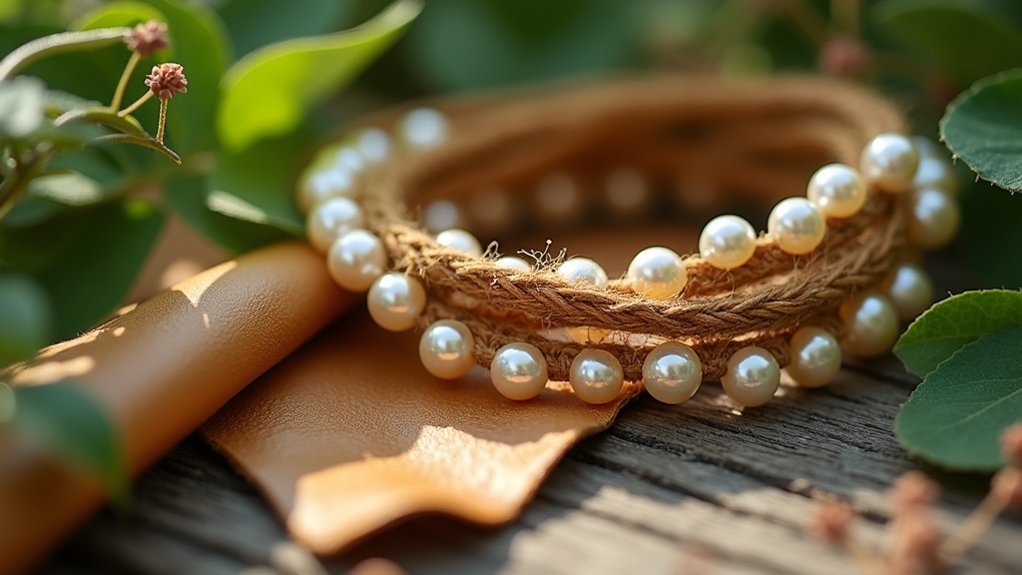



Leave a Reply